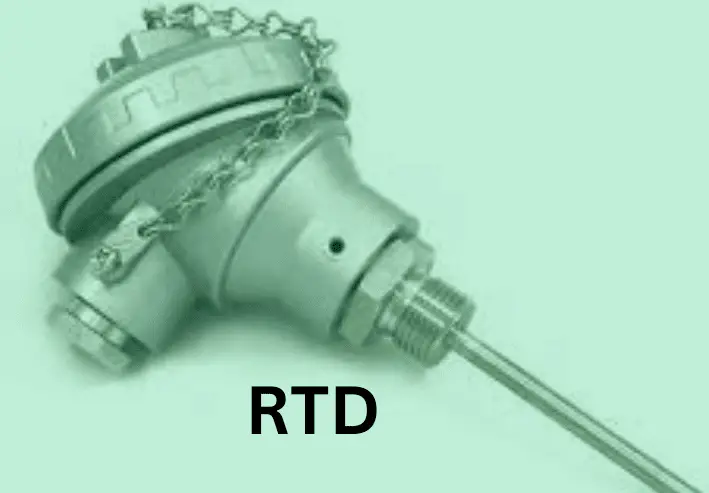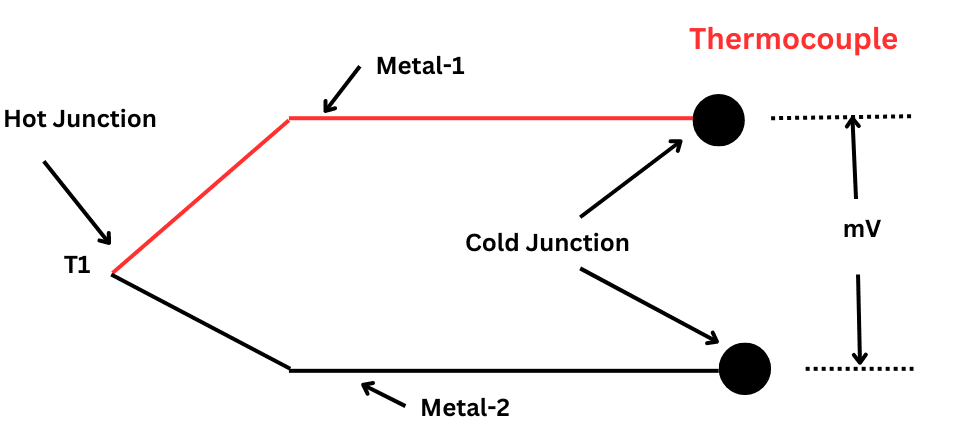The 4 Most Common Types of Temperature Sensors are NTC thermistors, RTDs, Thermocouples, and semiconductor-based sensors. These sensors for temperature are used for monitoring and controlling temperature in various applications.
Some applications, like life-saving medications, petrochemical plants, and nuclear power plants, need accurate and precise temperature measurements for critical quality control. On the other hand, some applications, such as monitoring temperature in the car, do not need accurate measurement.
We will discuss here four types of sensors for temperature measurement on the basis of measurement accuracy and responsiveness.
Temperature Sensor Types
The four types of temperature sensors are as follows.
- Resistance Temperature Detectors (RTD)
- Thermocouples
- NTC( Negative Temperature Coefficient )Thermistors
- Semiconductor-based Sensors
Now, we will discuss each type of temperature sensor.
1. Resistance Temperature Detectors(RTD)
The resistance temperature detector is a type of temperature sensor whose resistance changes with a change in temperature. As you know, the value of the resistance increases with an increase in temperature because the resistors have a positive temperature coefficient(PTC).

There are the following types of RTDs.
- Platinum RTD
- Nickel RTD
- Copper RTD
Among the above three types of RTD, platinum RTD has the highest accuracy. Therefore, Platinum RTD ( PT-100) is most suitable for applications where measurement accuracy with repeatability is paramount. The nickel and copper RTDs are less stable and repeatable. RTDs are available in film type and wire wound type. As per the application need, you can select a particular RTD. The thin film RTD can be fixed for measuring temperature in a confined space.
The platinum RTD has a good linear response and can be used for measuring temperatures in the range of -200 to 600 °C. However, a platinum RTD temperature sensor costs more than that of nickel and copper RTDs.
2. Thermocouple Temperature Sensor
A thermocouple has two metallic wires made of dissimilar materials. Both metal wires are connected at one side, forming the hot junction. The open ends of the wires form a cold junction. The thermocouple generates millivolts across the cold junction on heating of the hot junction. The output millivolts vary proportionally with a change in the temperature at the hot junction.

The measurement linearity and accuracy of thermocouples are less than the RTDs. Therefore. You need a conversion table to know the temperature according to the millivolts of the thermocouple. There are 8 types of thermocouple temperature sensors, namely- B, E, J, K, N, R, S, and T, and they are selected for applications as per the temperature range. The thermocouples are suitable for the measurement of high temperatures. They can measure the temperature from -200 °C to 1700 °C.
3. NTC( Negative Temperature Coefficient )Thermistors
A thermistor is a thermally sensitive resistor whose resistance decreases with temperature increases. It has lower resistance at high temperatures and higher resistance at low temperatures. The resistance decreases incrementally with an increase in the temperature, as per the resistance-temperature chart of the thermistor.
The small change in the temperature causes a large change in the thermistor’s resistance. Therefore, it reads the temperature accurately. The thermistor exhibits a nonlinear resistance-temperature relationship with an exponential R-T relationship. The nonlinearity can be linearized by suitable circuitry. The operating range of the standard thermistor is 150°C, and the operating range for glass-encapsulated thermistors is -50 to 250 °
4. Semiconductor-based Temperature Sensors
Semiconductor-based sensors use semiconductor materials to detect and measure measurements. The electrical conductivity of the semiconductor materials decreases with an increase in the temperature, and this property is used to measure the temperature. These sensors for temperature are compact and used to monitor the temperature of integrated circuits(ICs) and printed circuit boards(PCBs).
It has two identical diodes. Both diodes have temperature-sensitive voltage vs current characteristics. These characteristics of the diodes are used to monitor temperature. These sensors have a slowest but linear response and can measure temperatures from -70 °C to 150 °C.
These sensors are used in consumer electronics, industrial automation, healthcare, and industrial automation.